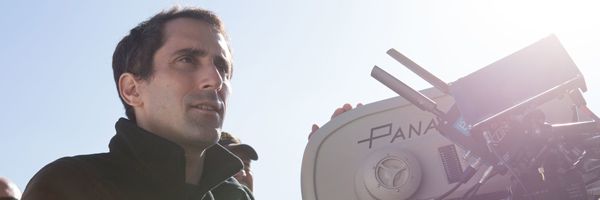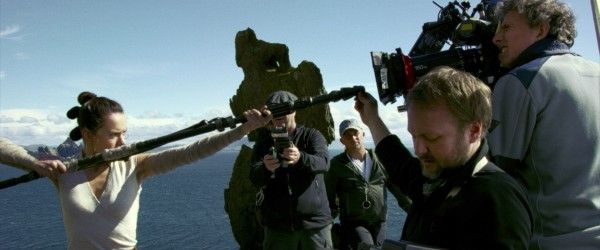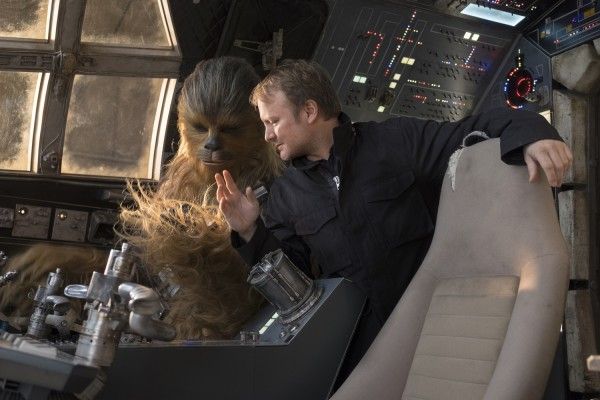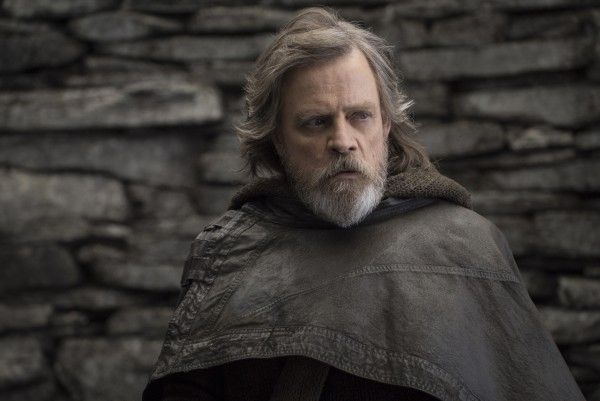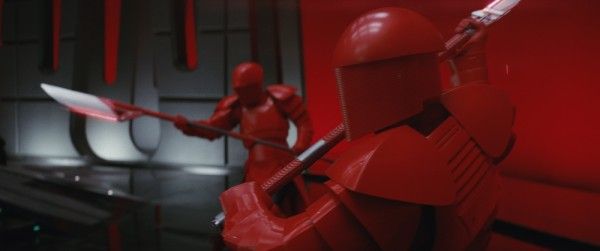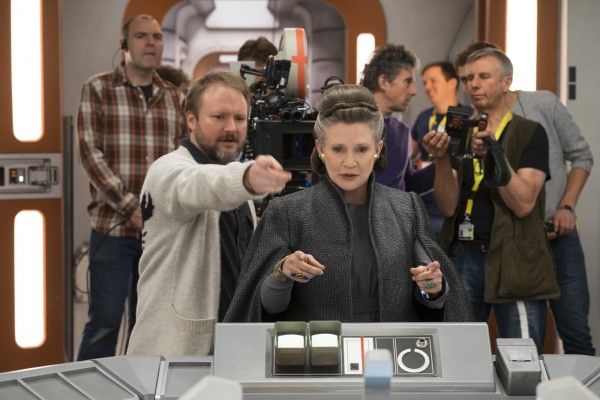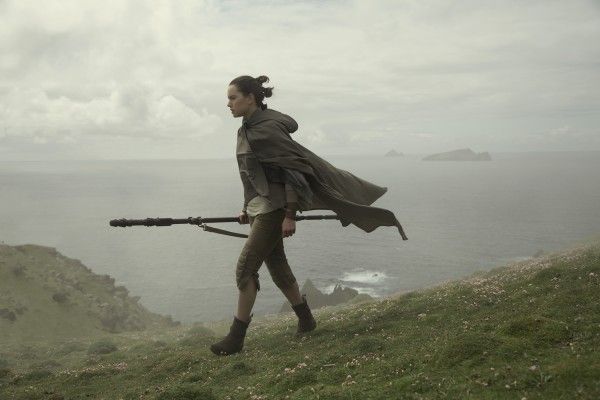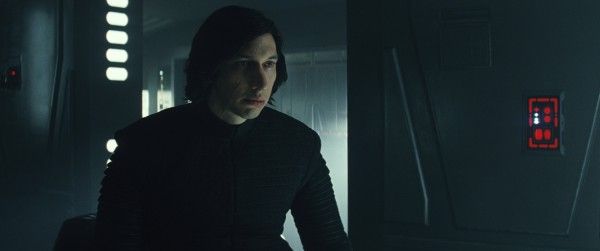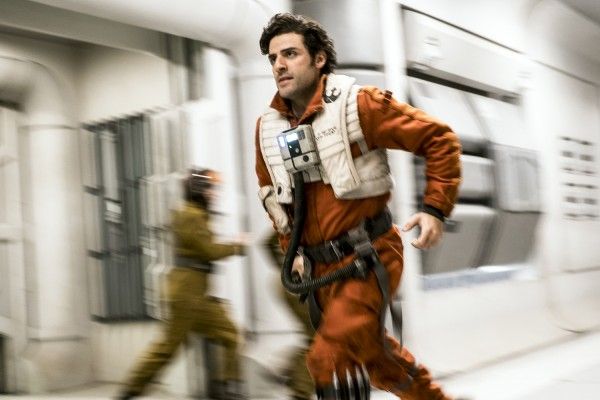Spoilers for Star Wars: The Last Jedi are discussed below.
When Rian Johnson was announced as the writer and director of Star Wars: Episode VIII, it came as something of a surprise, but a welcome one to be sure. Johnson hadn’t exactly made a big blockbuster movie before, but he also wasn’t some filmmaker with a single indie under his belt—he had been working consistently for years, expanding in scope with each successive film. Moreover, he’s a brilliantly unique storyteller, so audiences had faith that Johnson would deliver something original on this giant franchise canvas.
Indeed he did, as Star Wars: The Last Jedi is a bold, thrilling, wonderfully surprising sequel that is thematically satisfying and still, at a base level, wildly entertaining. One of the joys of watching the film was seeing just how gorgeous a Star Wars movie it is, and knowing that on The Last Jedi, Johnson was working once again with his longtime cinematographer Steve Yedlin.
Johnson and Yedlin have done stunning work together over the years, going all the way back to Johnson’s debut feature Brick, and Yedlin has a particular eye for interesting shots. With The Last Jedi the two craft their most visually arresting film yet, one in which each shot reinforces the thematic or narrative thrust of the scene, and one imagines the quality of the image has something to do with the relationship the two have built over the years.
I recently got the chance to speak with Yedlin about his work on the film during a press day for The Last Jedi, and while the conversation was all too brief, the cinematographer offered some terrific insight into his work on the Star Wars film. He discussed his working relationship with Johnson, how the two crafted such iconic shots within The Last Jedi, the use of the color red, and he talked specifically about putting together that unforgettable Throne Room sequence and Luke and Leia’s long-awaited reunion.
While I could have spent another hour peppering Yedlin with questions, this resulting interview offers fascinating insight into Yedlin’s work and his incredibly fruitful relationship with Johnson.
I know you and Rian have been working together for a really long time and I'm always curious with cinematographers, what were your early conversations on what you guys wanted to hit upon for the visual idea for this thing?
STEVE YEDLIN: Well, the very first time, I mean I really do remember the very first time Rian and I kind of talked about it. You know, like what we were actually going to do as opposed to just him informing me that he had been offered the job, taken it and bringing me on. We kind of had this discussion, which I think he had pretty much already decided in his head, but kind of wanted to bounce it off of me and say it out loud. But I think he pretty much already knew how much we were going to try to inform the visuals, based on the other movies, or try to specifically do something that we thought was Star Wars-y or something. And I think that the decision was kind of, you know, we're not really going to do that.
We're both very much inspired by Star Wars and especially Empire was just always there as an inspiration. But in terms of literally what are we doing? It's just let's figure out the most visually exciting way to tell this particular story in a way that excites us and feels personal. And you know, that's what we did. The genesis of the visuals was just this is Rian’s movie and we want to make it as visually amazing as possible, but not in a flashy way that's slapped on top of the narrative, but that the visuals are part of the narrative.
Clearly the color red is really important. I was wondering if you could talk about the use of that color in this film throughout, as kind of a motif.
YEDLIN: Yeah. I mean Rian obviously has some really big thematic stuff that's he's doing with that. Strangely, I mean because a lot of times he and I don't talk about that stuff literally, we don't start pontificating on the thematic stuff, it kind of feels like we already vibe with each other on that stuff. So we end up kind of, you know, the concept is there. We kind of both know why it's awesome and we delve right into the figuring out kind of the finer grain. How are we actually going to do this and make it awesome and make it full throttle where this isn't a half-measure but not look overcooked? So I think a lot of times when Rian tells me the visual anchors with this stuff, there's kind of that moment of being like, ‘Yeah Rian is brilliant.’ This is so thematically awesome in my head and then we just dive into figuring it out and we don't linger on all the, you know we kind of don't do a whole kind of literary criticism dissection of it.
Something that really struck me is that were so many great iconographic shots in this film. You have Luke and Leia reunited and Kylo and Rey fighting in slow motion and I was just kind of curious, did you guys storyboard a lot of these specifically? Were there any shots that came up super early in the process that you really, really, wanted to get onto film?
YEDLIN: Absolutely. Rian has always been such a planner and you know, this was no exception. How we communicate that plan had to evolve on this because more people had to understand it in detail. We just didn't have it where only me and him have to understand it in detail and the people only have to know the broadest strokes, because you know, between visual effects, stunts, art department, construction, physical effects, you know, there's so much to coordinate. So there's pre-vis and all that, but that was really just kind of an administrative thing of how are we communicating Rian's shot ideas.
But on the flip side, Rian is so visually strong and precisely authored. Like every shot is really meant to tell the story the best way possible. It's never flashy visuals or just kind of clumsy catch-as-catch-can. But that said, I mean this movie, actually some of the very strongest stuff he didn't plan as precisely. So it's not to say that it's clumsy, it's more just like he's confident now and rightly so, that he doesn't have to plan micro-details as much because he knows that the absolute best version—you know if you plan with false precision, you’re going to be blind to some details that are going to become obvious when you see all the other details there.
Even specifically with that Luke and Leia scene, that wasn't, unless I'm really forgetting something which is possible, I don't think that was storyboarded. We had that moment where they say that nobody's received a signal and then the attention shifts from them to her and then we drift into her across all the light flooding in from the broken door. And you know, unless I'm not remembering, I think that was the same, you know. Rian holds the finder and he finds the best shot to tell that story and then we put the camera there and light it. And it just felt fantastic and it did feel like he's able to come up with shots that are that beautiful and narratively meaningful. They're not just empty, you know it's not like, ‘Okay, first we have the narrative shot, then we stop and have a beauty shot.’ What's beautiful about it is the narrative efficiency, and he's even stronger now than he ever has been at both coming up with those shots in prep and also coming up with those shots in a scene like that, because it is actors in a room, it's not as much you know. It's not just a crazy combination of stunts and effects and all this stuff. He doesn't have to have an ironclad plan or stand by it. So that's not to say things aren't planned out but just that the plan can be looser where he doesn't know exactly, exactly the composition of that shot. And that allows him to create something even stronger sometimes.
I wanted to specifically ask about the Throne Room scene, where Kylo kills Snoke and you get this insane shot of Kylo and Rey fighting in slow motion. The theater went insane that I was in when that happened. I was curious if you could talk about the construction of that sequence and those shots and everything.
YEDLIN: Oh that's awesome. Again, it's a testament to Rian's visual storytelling and the narrative not being separate from the story. And also, you know, action not being separate from character. To have these character-based action scenes, I think that's part of why it feels emotional and not just like another fight scene, which we've seen so many of. But yeah, it really is a kind of testament to really planning this and everything coming together so that what we're doing on the set is not just figuring this thing out from scratch, it's just putting the final touches on this thing that's all been planned out. And now it's the part where we take this, you know if it was a novel, we're taking the summary and writing the actual sentence. We're not planning it all from scratch so it was like everything from figuring out that red room with Rick [Heinrichs, production designer] and all of that fight choreography.
You know, Rian had already worked that all out with the fight choreographers before, so we weren't fussing around with that. And it really was just making the absolute best version of this and the way that would physically come together on that set that day really wasn't any different than any other scene. Because the fight's figured out, there isn't hours of the stunt guys and fight coordinators figuring something out. They would just go to their positions, that way you have second teams down on their marks, the way you have the stand-in set stand on the marks to line up a shot. Rian would hold that finder and come up with just the most amazing, dynamic and exciting shots, but really, the best way to actually see what's happening narratively, too.
For more on The Last Jedi, peruse our recent links below:
- Why Kylo Ren Is the Anakin We Needed
- Rian Johnson Explains Why He Chose [SPOILER] for Rey’s Parents
- Why Rian Johnson’s ‘Star Wars: The Last Jedi’ Is “The Fandom Menace”
- ‘The Last Jedi': Rian Johnson Explains the Film’s First Luke Scene
- ‘Star Wars: The Last Jedi’ and the Problem with Fan Theories

